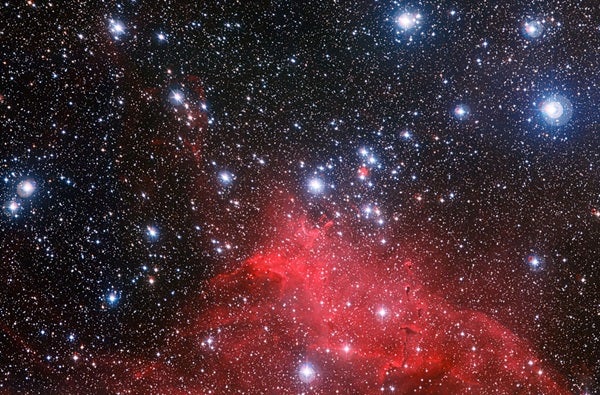Most stars do not form alone but with many siblings that begin life at about the same time from a single cloud of gas and dust. NGC 3572, in the southern constellation of Carina the Keel, is one of these clusters. It contains many hot young blue-white stars that shine brightly and generate powerful stellar winds that tend to gradually disperse the remaining gas and dust from their surroundings. The glowing gas clouds and accompanying cluster of stars are the subjects of a new picture from the Wide Field Imager on the MPG/ESO 2.2-meter telescope at ESO’s La Silla Observatory in Chile.
In the lower part of the image, a big chunk of the molecular cloud that gave birth to these stellar youngsters still can be seen. It has been dramatically affected by the powerful radiation coming from its smoldering offspring. The radiation not only makes it glow with a characteristic hue but also sculpts the clouds into amazingly convoluted shapes.
A strange feature captured in this image is the tiny ring-like nebula located slightly above the center of the image. Astronomers still are a little uncertain about its origin. It is probably a dense leftover from the molecular cloud that formed the cluster, perhaps a bubble created around a bright hot star. But some have considered that it may be some kind of oddly shaped planetary nebula — the remnants of a dying star.
Stars born inside a cluster may be siblings, but they are not twins. They are almost the same age, but differ in size, mass, temperature, and color. The course of a star’s life is determined largely by its mass, so a given cluster will contain stars in various stages of their lives, giving astronomers a perfect laboratory in which they can study how stars evolve.
These gangs of young stars stick together for a relatively short time, typically tens or hundreds of millions of years. They are gradually disbanded by gravitational interactions, but also because the most massive stars are short-lived, burning through their fuel quickly and ultimately ending their lives in violent supernova explosions, thus contributing to the dispersion of the remaining gas and stars in the cluster.










